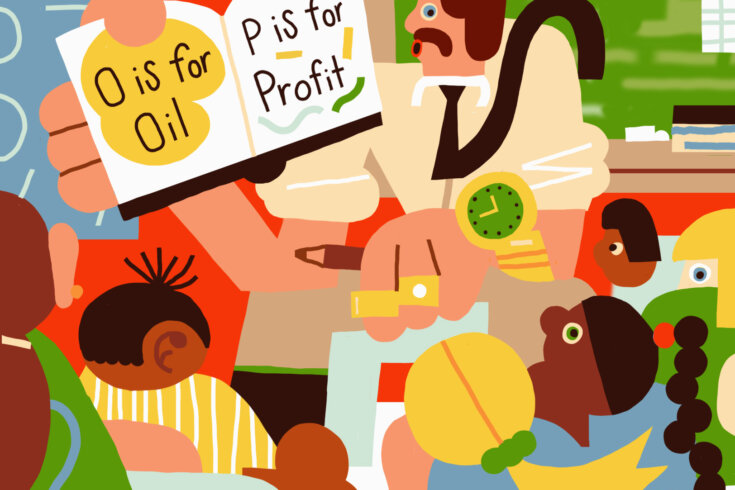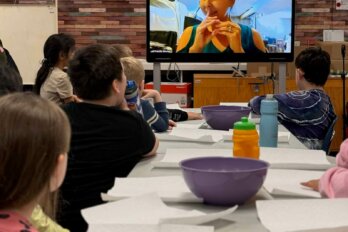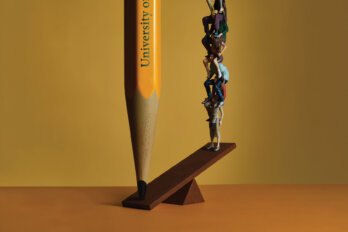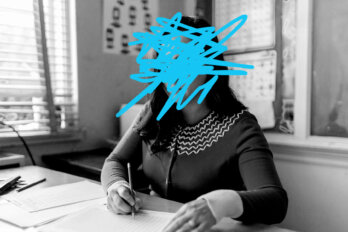Last fall, a seven-year-old elementary-school student in British Columbia brought a worksheet on physical and chemical matter home from class. His mother was shocked when she saw it. The worksheet came from a lesson plan created by FortisBC, a utility company that delivers natural gas and electricity to much of the province. Since 2017, the company has made ready-to-use lesson plans like this one—about climate change, energy conservation, natural-gas safety—freely available to teachers in the province to use in their classrooms. According to the company, as of 2020, more than 2,000 teachers had downloaded lesson materials from the company’s educational-program website.
Teachers typically develop their own plans, drawing on a variety of resources as well as their expertise and creativity. In some cases, though, they may rely on material prepared by other organizations such as TD Bank, which offers financial lesson plans for students from kindergarten to grade twelve. For a teacher strapped for time, FortisBC’s kits might have seemed like a gift, but buried within them are subtle nods to the company itself and the wider fossil fuel industry. These indirect endorsements reveal the veiled tactics of a sector desperate to delay the climate action that could upend its business model.
“Earth is heating up,” reads a slideshow from a grade seven lesson plan produced by FortisBC on the causes of climate change. It touches on the greenhouse effect and the difference between various greenhouse gases. It explains that these gases are released when coal, oil, and natural gas are burned and then directs teachers to ask their students how they use fossil fuels in their own lives, how their homes are heated, and how they get to school. Then the lesson plan instructs teachers to “explain that natural gas is the cleanest-burning fossil fuel, with the lowest carbon emissions.”
A grade ten science lesson produced by FortisBC could have noted that the International Energy Agency has determined that if the worst effects of climate change are to be avoided, there should be no further investment in new fossil fuel production. It could have also pointed out that the evidence is clear that the world needs to shift to renewable-energy sources, such as wind and solar. Instead, the message conveyed is that natural gas is the best option of all fossil fuels. A background paragraph in the lesson plan, ostensibly meant to explain the causes of climate change, reads like a sales pitch for the company’s product: “We still depend on fossil fuels,” the notes say, and of all the fuels, natural gas “is the cleanest-burning.” The backgrounder then offers a brief overview of methane: “Methane is released through the production and transportation of fossil fuels, as well as from livestock and the decay of organic waste.” Here, it’s what the sentence doesn’t say that stands out: that methane is a more potent greenhouse gas than carbon dioxide—and it can cancel out some of the short-term gains of switching from coal to gas—or that, according to the UN’s Global Methane Assessment report, the fossil fuel industry is one of the main producers of methane, and reducing those emissions is a way to help keep warming to just 1.5 degrees.
After the seven-year-old student brought the worksheet home, his mother, an emergency-room doctor, launched a campaign with the Canadian Association of Physicians for the Environment to ban such materials as well as all fossil fuel promotion from BC schools. The push was supported by dozens of organizations, including the BC Teachers’ Federation. In response to concerns, FortisBC said the lesson plans were developed by a sustainability-education consulting firm and fulfilled provincial requirements that utility companies develop educational programs on energy efficiency. The company has since removed the materials from its website while it undertakes an annual review “to ensure they provide relevant and balanced information.” (A spokesperson for the company told The Walrus that two third-party organizations are involved in the process, and each piece of lesson material is being reviewed for potential revisions.) With the world facing increasingly frequent and deadly weather events, public education about climate change has never been more important. What is “relevant” and “balanced,” then, in the context of the undeniable causes and consequences of climate change?
Ellen Field is an assistant professor in the faculty of education at Lakehead University’s Orillia, Ontario, campus who studies climate change education. In 2019, she led a survey of 486 Canadian students in grades seven to twelve, which found that just over half the students understood climate change is caused by human activities. Approximately 46 percent, however, said that it is about equally caused by human activities and natural causes; caused mostly by natural changes; is not happening; they were unsure; or they had other responses. Many students were unaware of the scientific consensus around climate change. Approximately 65 percent said “most climate scientists think climate change is happening,” and the remainder said that “there is a lot of disagreement among climate scientists about whether climate change is happening or not,” that “most scientists do not think climate change is happening,” or that they were unsure. A separate 2019 study found significant gaps in how climate change is covered in high school science curricula across Canada. In some cases, the researchers found curricula inaccurately portrayed climate science as a debate and often failed to adequately emphasize the negative impacts of or the potential solutions to climate change.
In a new study, currently under review, Field found that in all subjects in grades seven to twelve in most provinces and territories, climate change is found most often in elective courses taken in senior years of high school. (Recently, Yukon, Nova Scotia, and BC have updated their curricula to include climate change discourse in more mandatory courses.) Field found that few courses focus on the actions that can be taken to address climate change. In its April 2022 report on mitigating climate change, the Intergovernmental Panel on Climate Change once again made it clear that the world has limited time to drastically reduce emissions in order to avoid a worst-case scenario. But Field questions how we can expect voters to support climate policies if they don’t understand the full consequences of what the science is saying. There’s a “moral imperative to educate young people about the world that they will be graduating into,” she says.
Fossil fuel companies have long understood the power of the school system, according to Emily Eaton, a professor in the department of geography and environmental studies at the University of Regina. She points to a 1999 article in Oilweek, a former industry magazine, which explains how the then industry-funded Society, Environment, and Energy Development Studies Foundation, now called SEEDS Connections, aimed “to cope with ’90s fears, which at their alarmist worst suggest continuing to burn the fossil fuels will destroy the planet.” The article continues with a quote from its then president: “We’ve been able to convince the oil and gas industry that education is very important—not just to adults, but on a national level to the next generation of voters.” Schools, the article notes, are “a place to get what we call bias-balanced information into their hands.” In other words, the organization’s plan was to ensure industry perspectives were considered whenever environmental issues were taught in class.
That same approach is still in play today. In a 2020 study, Eaton and her co-author, Nick Day, interviewed teachers, administrators, and representatives who belonged to organizations that offer resources, school programs, or professional development related to energy and climate education for teachers in Saskatchewan. “Notably the industry funded non-profits all promoted fossil fuel interests and perspectives as legitimate and necessary to learning about environmental issues,” the authors write. Eaton and Day identified recurrent themes in the educational materials and programs put forward by industry-funded organizations. For example, the authors found that the prevalence of fossil fuels in everyday life was often highlighted. Where action to reduce greenhouse gases was considered, the emphasis was on individual actions, such as using energy-efficient light bulbs or taking shorter showers, rather than more systemic change.
These ideas show up in FortisBC’s lesson plans as well. In one meant for grades six and seven, students were asked to consider and track their own energy usage and come up with ways to conserve energy. There was no mention in the materials that addressing the climate crisis will require major changes to the way we get around our cities and towns, the sources of energy we use to power our economies, and the social inequities that leave some communities more vulnerable to the impacts of a warming world. (FortisBC says its lesson plans are age appropriate.) Grade six students are no strangers to complex issues: BC’s curriculum already expects students to learn about “global poverty and inequality issues, including class structure and gender” and “international cooperation and responses to global issues.”
“The days of denying climate change are over, finally,” Eaton says. “But what many people have called the new climate denialism is this idea that we’re actually denying the scale and speed, or pace, of the changes that are needed to rescue a habitable planet. And so that’s the kind of denial that I see in these types of resources.” Researchers have found that misinformation about climate change is shifting from outright denial of the science to more subtle efforts to delay cutting greenhouse gas emissions, says John Cook, a postdoctoral research fellow at the Monash Climate Change Communication Research Hub in Australia. Concentrating on individual actions is another subtle form of misinformation—it can delay broader climate action. Such a narrow focus is a “red herring,” says Cook, who argues it serves to distract people from the system-level changes needed to transition whole economies and societies off fossil fuels. “It’s a very insidious and it’s a very effective argument,” he says.
Cook’s research looks at misinformation-inoculation techniques at schools, essentially “teaching critical thinking to students,” he says. There are two parts to these methods: warning people about the risks of subtle tactics and giving them tools to recognize those tactics. Cook and a creative agency developed a critical-thinking game called Cranky Uncle as a way of teaching about misinformation with humour. So far, he estimates the game is being used by 400 to 500 teachers, including about twenty in Canada. A “cranky uncle” steers players through the various strategies, including fake experts or impossible expectations, employed by those who want to mislead others and then offers players a chance to test their knowledge through quizzes. The idea is to teach students “to spot misleading rhetorical techniques and logical fallacies,” Cook explains. “One thing that education can do really effectively is not just teach the facts but also teach how the facts can be distorted.
Teri Mooring, a former president of the BC Teachers’ Federation, says some teachers may have been using FortisBC materials to enlighten students about bias. For other teachers, the resources may have seemed like the answer to an age-old problem: too much to do in too little time. “It’s really time- and labour-intensive for individual teachers to be looking for resources, doing their own analysis around where the information is coming from, doing their own analysis around potential biases that occur,” says Mooring.
In 2021, a group of students launched Climate Education Reform BC to advocate for better pedagogy around climate change. The group is asking for modifications to the curriculum to ensure students learn about the causes and effects of climate change and the urgency of the situation as well as the political, economic, and sociological factors that have led to the current crisis. Crucially, it calls for climate change to be taught through a social-justice lens and for students to learn about how they can engage politically or spark a transformation in their future careers. At the same time, the group says teachers must be supported to teach about climate change with more resources and training. “If we do want to actually create change, we need everyone to have that baseline level of knowledge and mindset to be able to push for ambitious policy in the right direction,” says Sophia Bi, a recent high school graduate in Vancouver and a member of the student advocacy group.
While significant gaps remain in climate education across the country, reform is afoot. Aishwarya Puttur, a grade twelve student in Waterloo, Ontario, is a project coordinator with Teach the Teacher, a global campaign in which students have been trained in more than twenty countries to make presentations focused on climate change to the teachers in their schools. “The goal is to convey our message, convey our experiences as young people living through this crisis, and convey what we want to learn through our education,” Puttur says. “I even had one teacher tell me that she has now implemented the recording of my Teach the Teacher presentation in her environmental-law curriculum.”
Students are pushing for climate change to be incorporated into all courses: science and geography but also business and math. In math, Puttur suggests incorporating graphs that demonstrate climate change “instead of using a graph about how many dogs Susie has.” Above all, she says, “climate education should be framed in a way that incites hope and incites change.”
This story was supported by Journalists for Human Rights.





